How to Get Rid of Scabs on Scalp
We often spend countless hours of our life worrying over the state of our hair — is it too dry, too curly, too straight, too frizzy, too oily? But hiding underneath your tresses, like the forest floor from which all lush vegetation grows, is the all-important scalp. And when the scalp is unhealthy, it can lead to itchy, uncomfortable rashes, bumps, flakes and even hair loss. Of course, dandruff is the most familiar scalp condition, but there are several more that may require medical treatment. Here, a rundown of what causes seven common scalp conditions, and how to treat them. (Note: Since it's nearly impossible to get a good look at the top of your own head, check in with a board-certified dermatologist for a thorough evaluation and treatment plan.)
Psoriasis
Not to be confused with cirrhosis (liver damage), this condition affects about 1 to 2% of the general population and anyone can get it, at any age. Psoriasis can affect any part of the body, but the scalp kind is one of the most difficult types to treat, according to Seemal Desai, M.D., F.A.A.D., clinical assistant professor in the Department of Dermatology at the University of Texas Southwestern Medical Center. Why? The buildup of skin cells creates scaly, patches that can itch, hurt, crust up and bleed.
What it looks like: pink plaques with a silvery scale
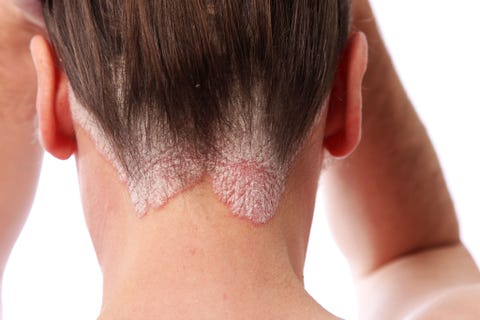
Getty Images
The cause:
- It's thought to be an autoimmune condition in which the cells in the top layer of skin are in overdrive.
- Overworking the scalp — from blow-drying and covering grays — can make the situation worse.
The treatment:
- Topical steroids, which control the inflammatory response, are the the most common treatment.
- Injections called biologics that help suppress what's causing the flare-ups in tougher cases.
- An excimer lase r can work on individual spots that are not responding to other therapies.
- A gentler hair routin e can also help, points out Dr. Desai. Not shampooing your hair every day may lessen the amount of skin rashes, or a therapeutic oil cream can also do wonders.
Folliculitis
Folliculitis is basically inflammation of the hair follicle; it appear as little pus bumps scattered throughout the scalp that look similar to acne. The bumps can sometimes feel sore.
What it looks like: scattered pus bumps
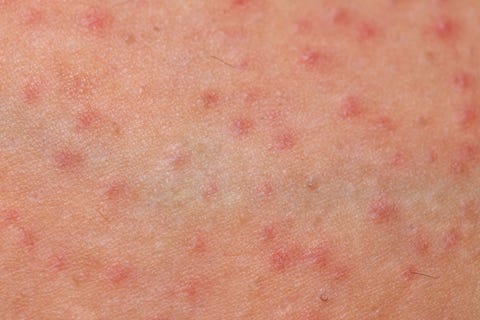
Getty Images
The causes:
- Bacteria (most commonly a staph infection)
- Irritation from shaving, heavy conditioners, potent hair dyes and excessive sweating.
The treatment:
- Topical or oral antibiotics may be prescribed if your doctor determines via a culture that bacteria is causing your scalp woes.
- Anti-inflammatory medications, such as topical steroid formulations, can be effective if there isn't an infectious agent present, says Christine Ko, M.D., professor of Dermatology and Pathology at Yale School of Medicine and author of the forthcoming book How to Improve Doctor-Patient Connection.
Seborrheic Dermatitis
Seb derm, as most derms call it, is one of the most common scalp conditions. Cradle cap in babies parlays into red, itchy patches with greasy scale or dandruff in an adult. It isn't contagious, but it can be embarrassing. Unfortunately, seb derm often comes and goes with triggers such as stress and seasonal changes — it's usually worse in winter and early spring. It can also affect the face, ears and chest. Dr. Desai recommends treating seborrheic dermatitis early and aggressively to avoid complications such as hair loss.
What it looks like: greasy scale and dandruff flakes
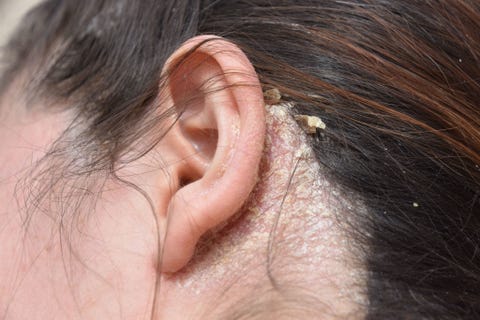
Getty Images
The cause:
- A yeast (fungus) called malassezia. which is in the oil secretion on the skin, it thought to be the culprit.
- Parkinson's, depression, diabetes, a weakened immune system, and obesity may make a person more likely to have seb derm.
The treatment:
- A prescription strength anti-yeast shampoo called ketoconazole can help. Since it can be very drying to the hair, Yolanda Lenzy, M.D., board-certified dermatologist and author of Getting to the Root: A Dermatologist's Guide to Understanding Hair, recommends applying the shampoo directly to your scalp 5 to 10 minutes before wetting the hair and then lathering only the scalp area before you rinse it off. "Follow with a moisturizing shampoo and conditioner on the hair shaft to prevent the dryness that Rx shampoos can often cause, especially in more coily hair types," advises Dr. Lenzy.
- A topical steroid may be prescribed if the shampoo doesn't work.
Hair loss
Hair loss can stem from a number of reasons; your doctor should do a thorough physical so that any underlying medical problems can be treated.
What it looks like: anything from hair breaking/shedding, to bald spots on your scalp
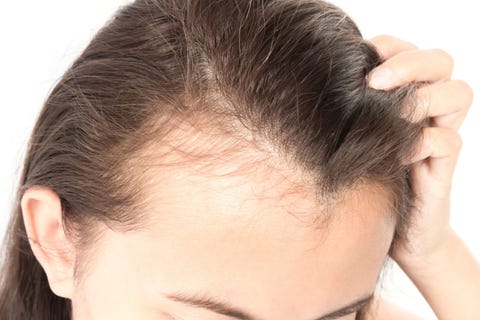
Getty Images
The cause:
"Hair loss can be due to a number of different factors, including genetics, medications, inflammation, hormonal abnormalities and hair fragility," says Dr. Ko. Regardless of the cause, it can be super distressing. If you notice hair breaking/shedding or bald spots on your scalp, it can help to get evaluated by a health care provider immediately. They may run blood work to evaluate for anemia, vitamin deficiency, thyroid abnormalities, irregular hormone levels and autoimmune markers.
Additional causes may include:
- Extreme stress, such as the death of a loved one
- Major weight loss (sometimes related to a high-protein diet)
- Infection and illness can cause a massive shedding months after the incident — a condition called telogen effluvium. For instance, a survey conducted by Survivor Corps found that nearly 68% of 1,700 COVID-19 survivors that were interviewed reported experiencing hair loss in the wake of their coronavirus infection. "Actress Alyssa Milano even recently took to Twitter to describe her experienced with COVID-19-related hair loss," notes Dr. Lenzy.
- Age can also play a role: As estrogen levels decrease between childbearing age and menopause, so often does our hair. Years of bleaching, dyeing, straightening, perming and rocking tight, slicked-back hairstyles can also catch up to us.
The treatment:
- Rogaine, a solution that thickens existing hair, and spironolactone, a pill that helps block hormones called androgens, can be helpful in cases of hormonal thinning.
- Eating a well-balanced diet filled with vitamins such as B12 and folate is also useful when experiencing hair health woes.
- Taking a break from over-processing your hair and rocking more natural styles is definitely encouraged.
- "Platelet-rich plasma (PRP) is an effective option for androgenetic alopecia (also called male and female pattern hair loss) and the residual thinning after telogen effluvium," says Dr. Lenzy. "During PRP, a patient's blood is drawn and the plasma, which is rich in various growth factors effective for stimulating hair regrowth, is isolated and injected or applied to the scalp with microneedling."
Cysts
Cysts can occur on the skin, just like they can show up on other organs. The good news: Scalp cysts are common and easy to identify. They are usually marble- or grape-sized bumps that you can feel when your comb or brush runs over them. If you're unsure about a bump or you can't get a good look of your scalp, that's a good time to consult a derm.
What it looks like: skin-colored or pink-red smooth bumps

Getty Images
The cause:
- For the most part, scalp cysts are mostly genetic.
The treatment:
- L eave it alone. This is an option if the cysts aren't bothering you, since they are mostly benign and no cause for concern.
- Have them drained: In some cases, however, they can get infected or irritated, causing pain. Incision and drainage can help calm down the symptoms, but won't remove the cyst in its entirety, says Onyeka Obioha, M.D., board-certified dermatologist at Cedars Sinai in Los Angeles.
- Antibiotics can also help relieve symptoms of an inflamed or infected cyst.
- Have them surgically removed by a medical professional. Cysts contain a fluid-filled sac. "Unless the sac is removed, the cyst can recur, thus surgery is the only effective option to completely remove a cyst and ensure it does not recur," says Dr. Obioha. Fortunately, the surgical removal is very simple and done with a local anesthetic. While it does leave a scar, Dr. Obioha says it's often not noticeable.
Ringworm
Also called tinea capitis, ringworm is a fungal infection that usually happens in little kids, but occasionally adults get it too. The rash is usually painful and scaly, sometimes even causing enlarged lymph nodes. It also can lead to bald spots, broken hairs and black dots.
What it looks like: scaly rash and bald spots
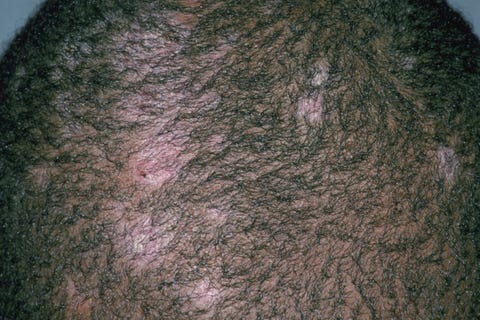
Getty Images
The cause:
- According to the Mayo Clinic, there are a few ways of contracting the fungus directly: human to human, animal to human (cats are a common source) and object to human (like clothing, towels, bedding, combs and brushes). However, "ringworm can also be transferred by indirect contact through a swimming pool or hot tub," says Dr. Obioha.
The treatment:
- Antifungal medication taken daily for 4 to 6 weeks usually does the job. "Ringworm is no longer contagious 48 hours after starting treatment," says Dr. Obioha. Until then, "you want to avoid contact with others as tinea capitis can spread through contact with other areas of the body and other people," she adds. Treating or discarding infected sources can help to prevent re-infection.
Allergic Contact Dermatitis (ACD)
This rash is a reaction to the scalp coming into direct contact with an allergen. "ACD can be painful, itchy and even oozing in some cases," says Dr. Obioha. The symptoms of a severe case can often be mistaken for infection." Fortunately, it's usually easy to figure out the cause because of the timing between chemical contact and rash.
What it looks like: itchy redness
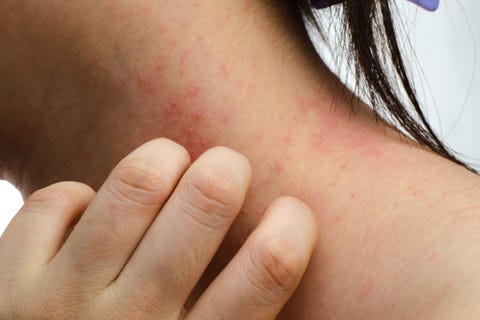
Getty Images
The cause:
- Hair dye: Paraphenylenediamine (PPD) is a chemical that is widely used as a permanent hair dye; it can wreak havoc on the skin and is one of the most common causes of scalp allergic contact dermatitis (ACD).
- Shampoos and conditioners: The chemicals/fragrances in shampoos and conditioners are also a common cause of ACD.
- Other chemicals: "Other relevant possible allergens include propylene glycol, Cocamidopropyl betaine, methylisothiazolinone (MI) or a combined formulation of methylchloroisothiazolinone and MI," says Dr. Obioha.
The treatment:
- Identifying the trigger and eliminating it.
- Topical steroid gel, foam, cream or ointment: Two to three weeks of treatment should help decrease inflammation and clear up your skin. "Systemic steroids may be prescribed in severe cases," adds Dr. Obioha.
*With additional reporting by Kaitlyn Pirie and Marisa Cohen
This content is created and maintained by a third party, and imported onto this page to help users provide their email addresses. You may be able to find more information about this and similar content at piano.io
How to Get Rid of Scabs on Scalp
Source: https://www.goodhousekeeping.com/health/a35426/common-scalp-issues-how-to-treat-them/